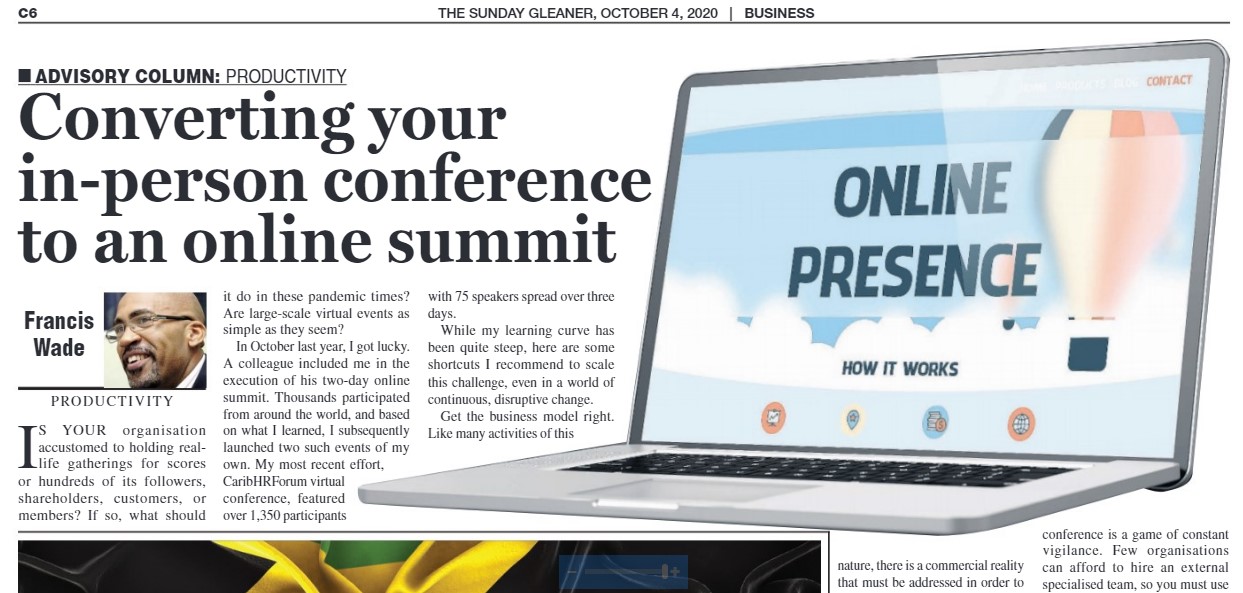Is your organization accustomed to holding real-life gatherings for scores or hundreds of its followers, shareholders, customers or members? If so, what should it do in these pandemic times? Are large-scale, virtual events as simple as they seem?
In October last year, I got lucky. A colleague included me in the execution of his two-day online summit. Thousands participated from around the world, and based on what I learned, I subsequently launched two such events of my own. My most recent effort, CaribHRForum Virtual Conference featured over 1350 participants, with 75 speakers spread over three days.
While my learning curve has been quite steep, here are some shortcuts I recommend to scale this challenge, even in a world of continuous, disruptive change.
1. Get the Business Model Right
Like many activities of this nature, there is a commercial reality that must be addressed in order to produce a material benefit. While it might appear easy to copy other online events, that’s a mistake if the organizers’ goals aren’t exactly the same as yours.
To illustrate, some hosts are happy to increase the size of their mailing lists. Others just want to sell a specific product to a narrow audience. The point is, your organization must define the outcomes and target dates it wants to attain from the venture.
For example, at the start you must choose which crowd to attract, what topics to cover, which technologies to use, what skills are needed and more. These are strategic decisions which should be driven by your organization’s vision. That’s not to say the past should be ignored: but you should assume that you are looking to attract a younger, more tech-savvy version of your traditional audience.
By now you may realize: this is not simply about making a virtual carbon copy. Instead, this activity should complement your new post-COVID strategy and the best way to accomplish this is from a blank canvas.
2. Hunt for Skills
Unfortunately, the team of folks you relied on to pull off your in-person events may find itself lacking. The skills needed for a project of this nature are vast, deep and changing from one month to the next. As such, it’s unlikely that you will find them all at once. In other words, expect team members to be in a relentless learning mode as they grapple with evolving technologies.
For example, you’ll need folks who are skilled in internet marketing, website design, customer service, online community management, copywriting, image and video editing, event handling, speaker selection/training and more. While some of these may appear to be traditional capabilities, the virtual expression of them is unique.
Case in point: A skilled graphics designer accustomed to a traditional role may not understand the difference between Instagram Story promotions versus those in the Feed. Facebook’s advertising platform may be incomprehensible.
The bottom-line is that managing the skills needed for a virtual conference is a game of constant vigilance. Few organizations can afford to hire an external specialized team so you must use volunteers or employees. They will only possess a subset of the skills you need so get everyone in learning mode from the onset.
3. An Early Start
Most organizations under-estimate the need for a business model that works and the skills which are needed. Consequently, they start working on their online conference far too late.
This has a compound effect: an overdue start means a lesser choice of speakers. This, in turn, makes the event unattractive to your audience. They may conclude that you’re only offering a glorified webinar: heavy on splashy graphics and light on content. Unfortunately, fewer attendees means less revenue.
A late start may also push you into offering live presentations, versus those which are pre-recorded. While this may seem to be an easy substitute, it actually translates into a frantic last-minute struggle to bring together interviewers, interviewees and the audience in real time. Throw in different time zones, imperfect technology and a tricky supply of electricity or Internet access and you have a recipe for stress.
In these pandemic times, these are challenges you may not be able to avoid. Accept the fact that you are creating an experience that is distinctly different from ones you have undertaken in the past, and that direct comparisons to pre-COVID times add little value.
The truth is, in-person gatherings in large numbers are unlikely to resume in 2021. In the meantime, many of your audience members will become accustomed to the benefits of virtual conferences and summits, and start to prefer this option.
Embrace this aspect of the new normal as a unique capability to be used long beyond the time when herd immunity sets in. Instead, it will probably be a requirement your audience demands, a feature your organization will offer over and over again in the future.

